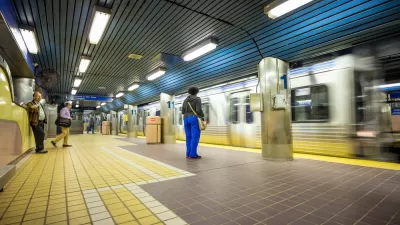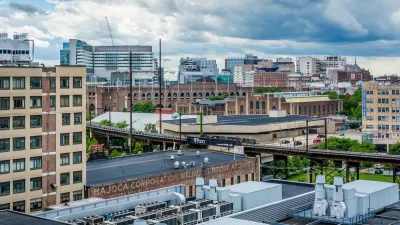The Philadelphia Inquirer's architecture critic sets out to find the outer edge of the Philadelphia suburbs, and finds a "zombie subdivision."
"Oakcrest has a network of immaculately paved streets, glossy utility boxes, and an active sales office. What it does not have is a lot of houses," writes Inga Saffron.
"Oakcrest was laid out for 169 single-family homes, but only 32 were completed when the builder went belly up after the 2007 housing crash. The result is a kind of zombie subdivision: Oakcrest is outfitted with all the necessary infrastructure, but it lacks the pulse of human life. Numbered signs resembling grave markers have been jammed into the earth to identify the available house lots."
Is this just another victim of the housing crash, Saffron wonders, or "a sign that the region's suburban sprawl has finally reached its limit?"
Saffron uses the Oakcrest example to review the debate between suburbia and increased density: " 'The word suburb has lost its meaning," acknowledges Alan Berube, a fellow at the Brookings Institution. The real competition, he suggests, is no longer between cities and suburbs, but between places that have density and good transit connections and those that don't. By that definition, North Philadelphia could be well-placed for a comeback, but the city's suburbanized Northeast may struggle. The success of Collingswood has everything to do with the proximity of PATCO trains and its small house lots... It's low-density, fringe exurbs like Oakcrest, beyond the orbital pull of the big city, that may not have much of a future."
Thanks to Architect Magazine
FULL STORY: Changing Skyline: Suburbia's outer ring losing shine, some economists say

Alabama: Trump Terminates Settlements for Black Communities Harmed By Raw Sewage
Trump deemed the landmark civil rights agreement “illegal DEI and environmental justice policy.”

Study: Maui’s Plan to Convert Vacation Rentals to Long-Term Housing Could Cause Nearly $1 Billion Economic Loss
The plan would reduce visitor accommodation by 25% resulting in 1,900 jobs lost.

Planetizen Federal Action Tracker
A weekly monitor of how Trump’s orders and actions are impacting planners and planning in America.

Waymo Gets Permission to Map SF’s Market Street
If allowed to operate on the traffic-restricted street, Waymo’s autonomous taxis would have a leg up over ride-hailing competitors — and counter the city’s efforts to grow bike and pedestrian on the thoroughfare.

Parklet Symposium Highlights the Success of Shared Spaces
Parklets got a boost during the Covid-19 pandemic, when the concept was translated to outdoor dining programs that offered restaurants a lifeline during the shutdown.

Federal Homelessness Agency Places Entire Staff on Leave
The U.S. Interagency Council on Homelessness is the only federal agency dedicated to preventing and ending homelessness.
Urban Design for Planners 1: Software Tools
This six-course series explores essential urban design concepts using open source software and equips planners with the tools they need to participate fully in the urban design process.
Planning for Universal Design
Learn the tools for implementing Universal Design in planning regulations.
Caltrans
Smith Gee Studio
Institute for Housing and Urban Development Studies (IHS)
City of Grandview
Harvard GSD Executive Education
Toledo-Lucas County Plan Commissions
Salt Lake City
NYU Wagner Graduate School of Public Service




























